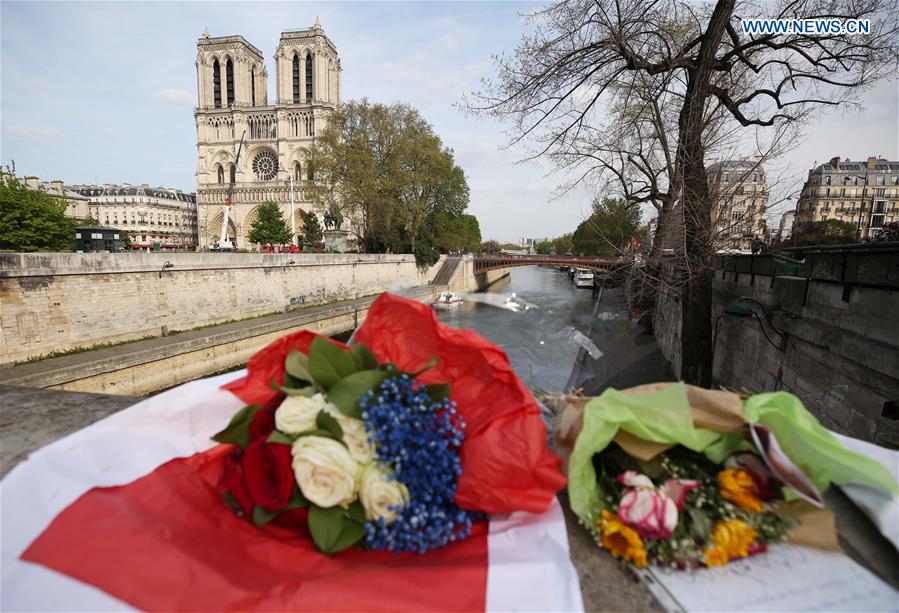Human society should focus on better protecting historic monuments
- By Rachana Gupta
 0 Comment(s)
0 Comment(s) Print
Print E-mail China.org.cn, April 23, 2019
E-mail China.org.cn, April 23, 2019

A massive fire that broke out last week in one of the most beautiful and iconic Gothic Cathedrals, Notre Dame in Paris, shocked not just onlookers but the entire world.
The 850-year-old cathedral is a Catholic place of worship, a museum of arts and artifacts, and a world-famous historic tourist site. In this cultural tragedy, the cathedral's 750-ton iconic spire, originally constructed in the 13th and rebuilt in the 19th century of lead-covered oak, along with much of its roof collapsed within an hour of the fire being detected.
Fortunately, many of its valuable artworks, relics and its exquisite glass windows dating back to the 12th and 13th centuries remained unscathed. However, officials warned the cathedral may still have serious vulnerabilities, particularly in the soaring vault.
While an investigation is still ongoing to determine the exact cause of the fire, an electrical short circuit in the roof being the prime suspect, many philanthropists and business conglomerates from France and across the world have come forward to support reconstruction. So far, more than US$700 million in private donations have poured in.
From a wider view, the Paris incident has caused serious concern about the safety of other historic monuments around the world, and safety reviews have already begun in many places.
For instance, Spain's cultural minister Jose Guirao called for a special meeting to discuss a plan to protect cultural goods in case of an emergency. He said Spain would review security arrangements and electrical fittings at its historic sites to mitigate any risks.
In the similar vein, Lisa Ackerman, interim CEO of the World Monuments Fund, recently pointed out that historic buildings made of wood or featuring decorative wooden elements were of serious concern, highlighting the importance of preventive maintenance and constant care.

This is not the first time an iconic structure caught fire and attracted media attention; there have been similar incidents before where historic monuments got extensively damaged. In the last decade, there has been disasters striking Souk marketplace in Aleppo, Syria, the National Museum of Brazil, the Royal Clarence Hotel in Devon, England, and the National Museum of Natural History in New Delhi, India.
The Souk marketplace in Aleppo was a center of cultural exchange during Ottoman rule of the 16th century. It was ruined when fire broke out in 2012 during the clashes between the Syrian government and opposition forces. Another tragedy happened at the Brazilian capital Rio de Janeiro in 2018 when the National Museum of Brazil caught fire, fortunately causing no loss of life but at huge cultural cost as the museum lost 90% of its artifacts along with its renowned Egyptology collection.
The Royal Clarence Hotel in Devon was built in 1769 and got its name after the Duchess of Clarence stayed there in 1827. The iconic structure collapsed due to a massive fire in the year 2016.
In the same year, New Delhi's National Museum of Natural History, founded in 1972 and famous for its 160-million-year-old sauropod dinosaur fossil, was destroyed in a mighty blaze. Fire officers later confirmed that most of the museum's collection was destroyed along with the dinosaur fossil.
It is quite clear that these structures hold a significant value in the society as symbols of various stages of advancement of human civilization, its knowledge, culture, and faith.
The monuments are also the sign of the legacy left by our ancestors. These have helped people not just in the past, but also in the present to understand the various steps involved in the advancement which eventually led to the formation of the present-day modern society.
Thus, it is not just important, but of utmost significance, for us to better protect iconic structures not just for ourselves but also for future generations.
Rachana Gupta is an active blogger, poet and freenlance content writer.
Opinion articles reflect the views of their authors only, not necessarily those of China.org.cn.
If you would like to contribute, please contact us at opinion@china.org.cn.






Go to Forum >>0 Comment(s)